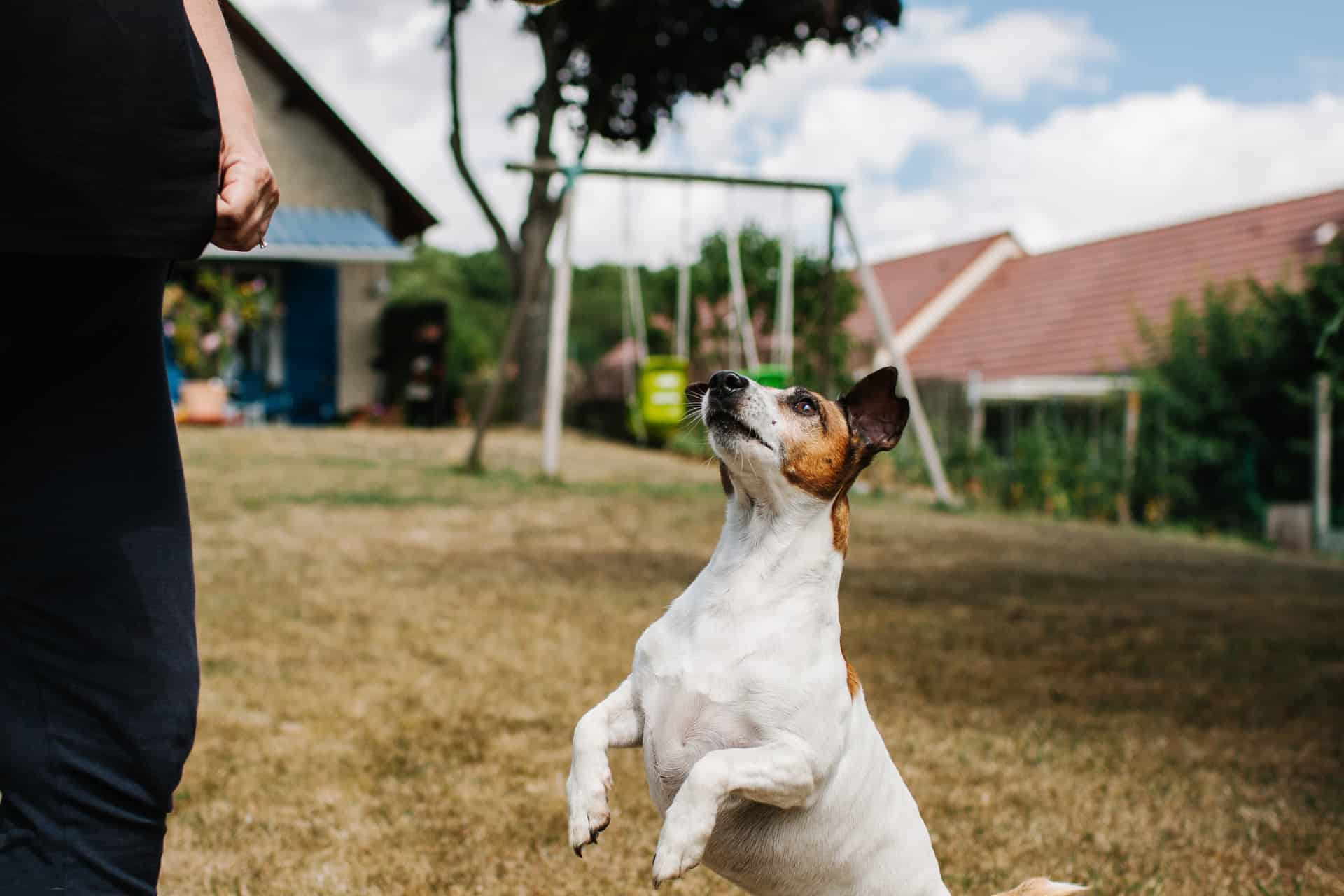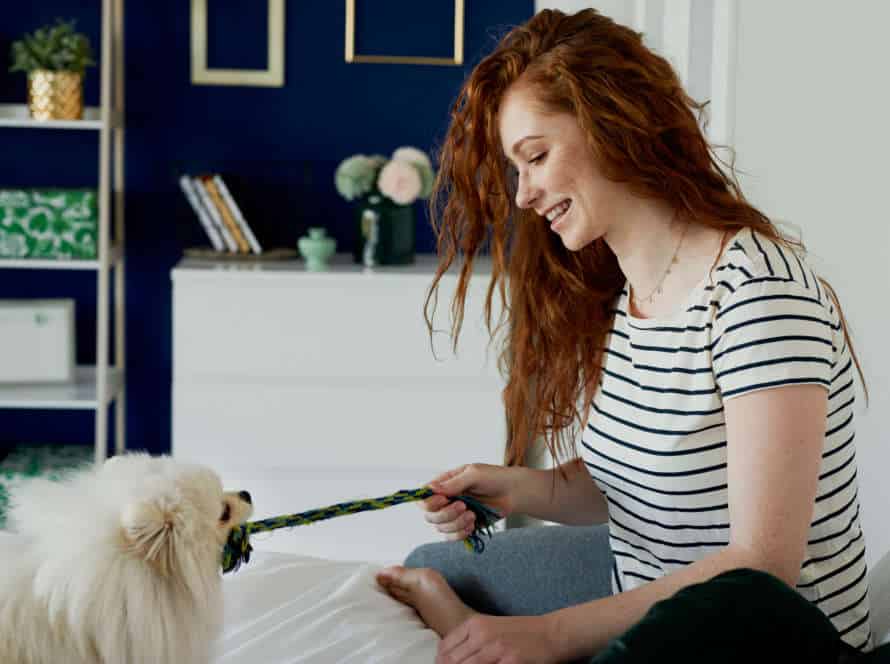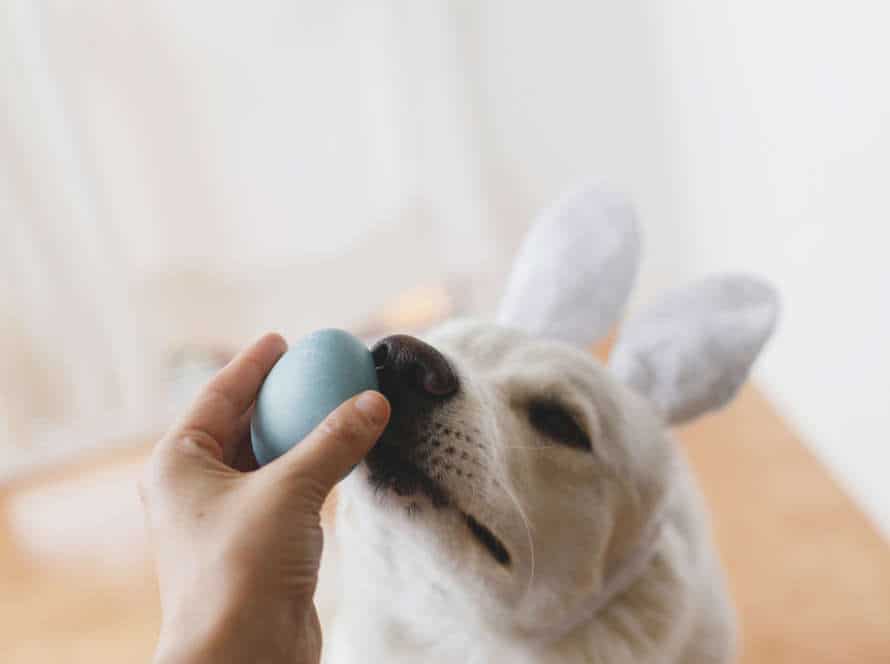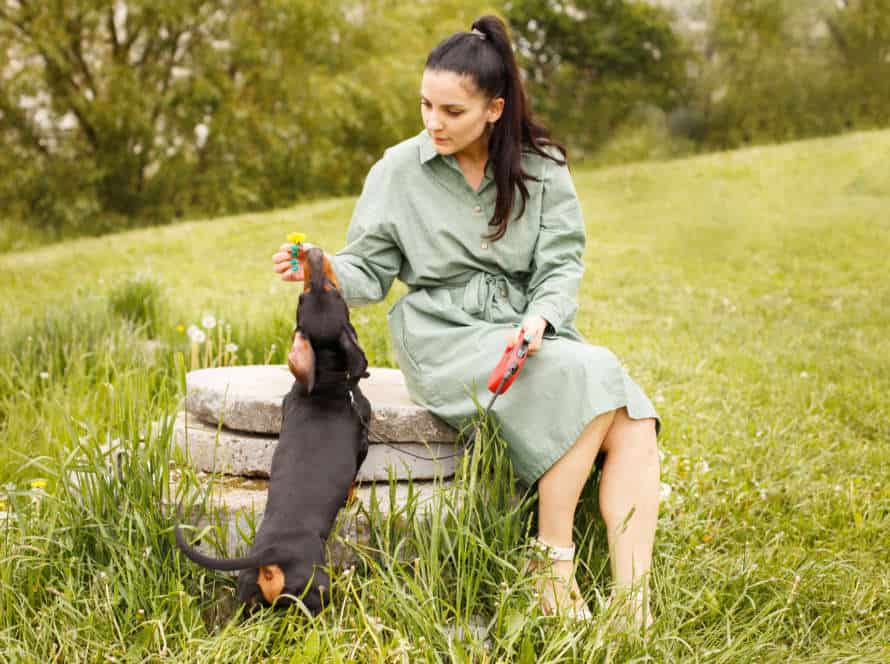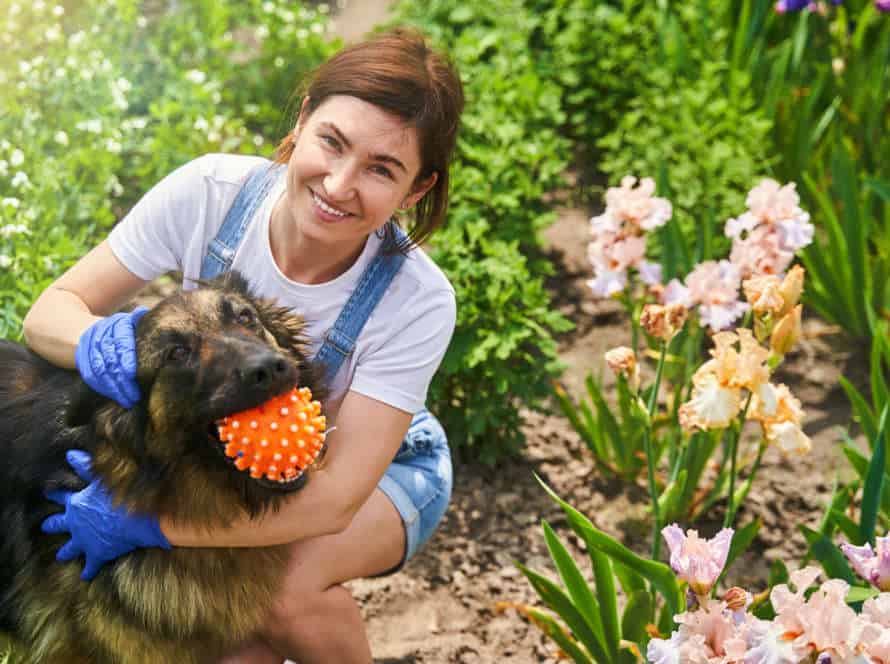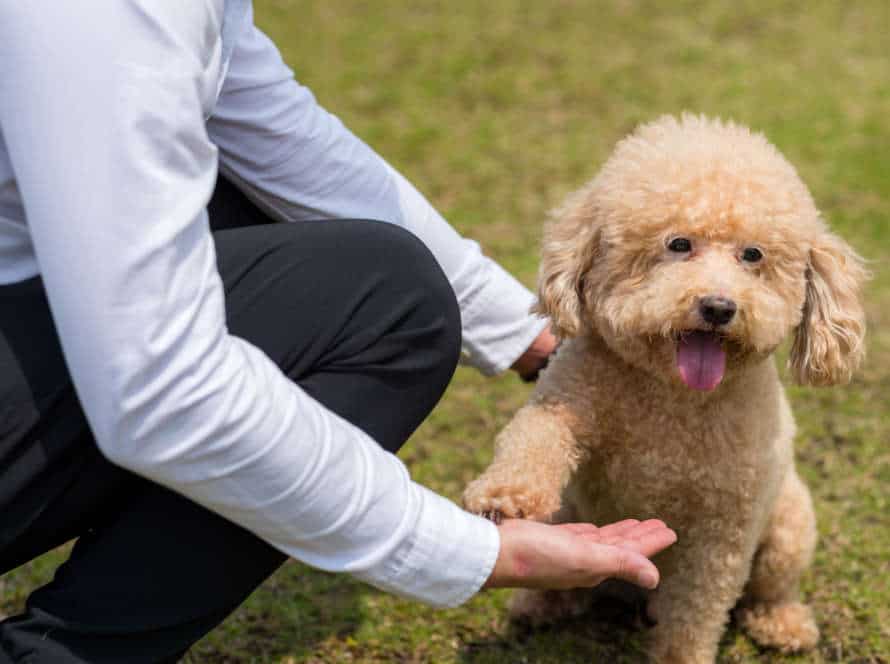Trick Training for Mental Stimulation: Boost Your Dog’s Brain
Trick training is a great way to get your pup’s brain active. To begin, start with easy tricks like “sit”, “stay” and “shake”. Reward with treats and praise. Next, move up to more intricate tricks like “roll over” and “play dead”. Keep your pup engaged and challenged by adding new tricks. Change up training spots and environments to help your pup focus and adjust. Interactive toys like puzzles and agility equipment can provide extra mental stimulation. Trick training helps your dog think better and strengthens your connection. So, start trick training today and watch your dog’s brain soar!
Why Mental Stimulation is Important for Dogs
Mental stimulation is a must for dogs. It keeps them sharp and alert, heightens their attentiveness, and eliminates stress and anxiety. Furthermore, activities like trick training help construct and preserve a strong relationship between you and your pup.
Let’s look at the advantages of mental stimulation and how to use trick training to get it.
The Negative Effects of Boredom
Boredom can have bad effects on dogs. So, to stop this, it’s important to give them mental stimulation. A great way to do this is through trick training!
If they don’t get enough mental stimulation, they may act out, be anxious, and be sluggish. Trick training helps avoid this and gives them the mental stimulation they need.
Tricks like ‘sit’, ‘stay’, ‘heel’, and ‘roll over’ can get your pup’s mind going. And, more complex tricks like jumping through hoops or weaving through cones are also fun!
Furthermore, trick training strengthens the bond between you and your pup. It requires positive reinforcement and communication. If you want your pup to stay motivated, use treats such high-value treats like chicken or cheese!
Benefits of Mental Stimulation
Mental stimulation is just as important as physical exercise for dogs! It engages their brains, boosts cognitive ability and keeps them happy and healthy. Here are some of its benefits:
- Avoids Boredom & Bad Habits: Stopping boredom and habits like chewing, digging and barking.
- Enhances Intelligence: Improves problem-solving, memory and learning.
- Boosts Confidence & Socialization: Trick training can help with socialization, confidence and new situations.
- Plus Physical Exercise: Essential for good health, weight and avoiding issues like obesity and joint problems.
Trick training is a great way to provide mental stimulation and strengthen the bond with your pup.
The Role of Trick Training in Mental Stimulation
Mental stimulation is key for dogs. It keeps them happy and healthy, same as humans! A great way to provide this is through trick training. Here are some of the advantages:
- Strengthens the connection between you and your pup.
- Helps them learn something new.
- Gives them a channel to release energy.
- Gives them a sense of accomplishment.
Introduce the tricks gradually, with motivation and praise, not punishment. Start with simple commands like ‘sit’ and ‘stay’, then work up to harder tricks. Not only does it stimulate their minds, but it’s also a great way to have fun and bond.
Pro-tip: Train your pup before meals. They’re usually pretty motivated by food, so this helps them learn faster.
Getting Ready for Trick Training
Trick training – it’s a blast! It’s great for your dog’s body and mind. You and your pup will have lots of fun. But, there are some steps you should take before starting. Here are the top ways to get prepared. Enjoy!
Understanding Your Dog’s Learning Style
Know your pooch’s learning style for successful training and trick learning. Dogs usually show three main styles.
- Visual learners: These respond to visual cues. They learn by watching others do tricks.
- Auditory learners: They react to sounds and tones. They follow commands with verbal cues and rewards.
- Kinesthetic learners: They prefer hands-on learning. They respond to physical cues and touch.
Once you know your dog’s style, modify your training methods and use tricks that suit them. Mental stimulation through trick training makes your furry friend happy.
Plus tip: Positive reinforcement is essential. Reward good behavior with treats, praise, and love for best results.
Setting Up For Success
Creating success is a must for training your pup in tricks! It’ll provide mental stimulation which helps their brain activity, and also develops their cognitive abilities. Here are some tips to get you ready:
- Choose the right spot – Choose a peaceful, low-distraction area to teach your pooch. Avoid places with a lot of people, the TV, or loud music that could distract them.
- Positive reinforcement – Reward your dog for their hard work with treats, toys, or lots of praise. This will make them want to keep doing it and also bring you two closer.
- Start with the simple stuff – Begin with basic tricks your pup can easily learn and then move on to more challenging ones. Make sure it’s fun and rewarding for both you and your pup.
- Be consistent – Consistency is the key for successful trick training. Set aside the same time each day to practice and stick to it. Your pup will learn better if they have a routine.
Pro tip: Trick training not only boosts mental stimulation, but also provides an opportunity to bond with your furry friend. So, have a blast and enjoy the process!
Positive Reinforcement: Making Learning Fun
Positive reinforcement is a fun and effective way to train your pup! Instead of punishing them for bad behavior, reward them for good behavior. This technique will help you strengthen your bond with your pooch. Here are some tips for making learning fun:
- Use treats like cheese, chicken, or hot dogs as rewards for good behavior.
- Keep training sessions short and upbeat.
- Be consistent with commands and rewards.
- Add mental stimulation with trick training.
- Remember, training should be a fun experience for both of you! With patience, consistency, and positive reinforcement, you and your pup can become the happiest companions.
Pro tip: Short, positive sessions will keep your pup motivated. Enjoy!
Basic Tricks to Get Started
Trick train your furry friend to keep them entertained! Stimulating their mind and building their self-confidence – it can all be done with trick-training! From the basics like ‘sit’ and ‘stay’, to more advanced ones like ‘spin’ and ‘fetch’, there are lots of fun tricks to learn.
Let’s get started on some of the more basic ones!
Sit, Stay, and Come
Train your four-legged friend some cool tricks like sit, stay, and come! This can help you build a strong bond with your pup while providing them with mental stimulation and exercise too! Here are some handy tips to get you started:
- Begin with simple commands like “sit“, “stay“, and “come“.
- Use positive reinforcement methods like treats or praise to motivate your pup to obey.
- Utilize short, consistent commands and be patient with your pup. Give them time to understand and perform the command correctly.
- Spice up your training sessions with fun toys and games to keep your pup interested.
- As your pup gets better at it, slowly increase the difficulty of the commands. This will give them the mental stimulation they need to progress and learn. Pro tip: Always reward your pup for good behavior and recognize their improvement, this will encourage them to learn more tricks!
Shake or High-Five
Shake paws or give high-fives – these are some basic, yet effective tricks to start training your pup! Not only will this boost their mental stimulation, but also improve the bond between you and your pup.
To teach your pup how to shake or high-five:
- For shaking paws:
- Get your pup to sit.
- Hold a treat in your closed fist near their paw.
- Wait ’til they paw or sniff at your hand.
- Open your hand so their paw falls into your open palm.
- Give the treat and praise them.
- For high-fives:
- With pup sitting in front of you, hold a treat in your hand in front of their paw.
- Wait ’til they paw or touch your hand.
- As soon as they do, give the treat & praise.
- Increase the height of your hand until they give you a high-five.
Remember to be patient & consistent while training. Positive reinforcement techniques are key to encourage good behavior. Trick training is a great way to keep your pup mentally stimulated between regular walks & playtime!
Roll Over or Play Dead
Roll Over and Play Dead are two tricks which keep your pup’s mind active and help their brainpower. Here’s how to show your furry friend these moves:
- Roll Over: Get your dog to lay down. Then, move a treat close to their nose and slowly slide it towards their shoulders. Your pooch should roll over to follow the treat. Give them the treat and praise them when they do.
- Play Dead: Ask your dog to lie down. Gently roll them onto their side while saying ‘play dead’. Wait a few seconds before rewarding them the treat. Make the time longer before giving them the reward each time.
These tricks not only give mental stimulation to your pup, but also boost the bond between you and your furry friend.
Intermediate Tricks to Challenge Your Dog
Trick training is a neat approach to keeping your pooch mentally active and involved in activities. Intermediate tricks are ideal for challenging your pup and keeping them interested in learning new stuff. In this article, we’ll explore some ideas for intermediate tricks which can help you supercharge your dog’s brain. From weaving through your legs to discovering concealed treats, let’s jump in and find out more about these exercises and their advantages.
Spin or Twirl
Spin or Twirl is a trick to mentally challenge and enhance your dog’s physical skills. To teach it, start with your pup in a standing position. Put a treat in front of their nose to grab their attention. Move the treat around in a circle and keep going until your dog completes a full spin. Give them the treat and praise them. Repeat this several times, speeding up and increasing the distance of the spin each time. Once they can spin one way, train them to do it the other way too!
Pro Tip: Give verbal praise and treats for every successful spin or twirl. Keep the sessions short and upbeat to keep your pup engaged and motivated.
Jump through a Hoop
Jumping through any object is a great way to stimulate your pup’s mind. Hoop jumping is a fun variation! Here’s how:
- Choose a hula hoop big enough for your pup to leap through.
- Hold it vertically and let your pup smell and look at it.
- When they are close, say “jump” or “hoop” and encourage them to leap through.
- Reward with treats or praise when they succeed.
- Gradually increase the height of the hoop.
- Keep training sessions short and sweet. Practice regularly to boost their skills and intelligence.
Pro tip: Be patient and reward them for effort, even if they don’t get it right the first time. Enjoy bonding with your fur-pal!
Dance or Bow
Dance and Bow are two challenging tricks that can stimulate your pup’s mind during training.
To teach them:
- Dance: Hold a treat up to their nose. Get them to stand on their back legs. Move the treat around above their head and they’ll spin. Say “dance” and give them the treat once they’re done.
- Bow: Have your pup stand in front of you. Hold a treat up to their nose and move it down, so their front legs bend and their head goes towards the floor. Say “bow” and give them the treat when they finish.
Learning these tricks can improve their coordination, focus, and mental stimulation during training.
Advanced Tricks for an Extra Challenge
Did you know? Tricks training can help exercise your pup’s brain and keep them sharp! It’s more complex than regular tricks, so it’s a bigger challenge and more mentally stimulating. Advanced tricks can stop your pup from getting bored and make your bond tighter.
Here’s some tips on how to keep you and your pup engaged in trick training:
Weave between Legs
“Weave between legs” is a tricky feat to teach your pup. Here’s how:
- Stand with legs apart and summon your pup to you.
- Hold a treat in one hand and lure them to the side of your leg.
- Guide them with other hand to the other side, following treat.
- Praise and reward with treat when on other side.
- Repeat, reducing guidance with other hand.
- As pup becomes more confident, increase speed and add more weaves.
This trick stimulates pup mentally and strengthens bond between you two.
Play Dead with a Twist
“Play Dead with a Twist” is an advanced trick for your pup. It’ll boost their brainpower and strengthen your bond. Here’s how to teach it:
- Start with the basic “play dead” command – get them to lie on their side.
- Add a twist – get them to roll onto their back.
- Use positive reinforcement & treats when they complete it.
Remember to never force your dog to perform if they’re not willing. Keep a close eye on them.
Pick Up Toys and Put them Away
“Pick up toys and put them away” is a great way to stimulate your pup’s mind. Here’s how to do it:
- Teach your pooch to pick up a toy with its mouth and drop it in a bin.
- Then, make it harder by using smaller toys or asking for multiple toys at once.
- You can also have your pup differentiate between toys based on their color, shape, or size. Put them in the right bins.
- Finally, ask your pup to put away all the toys into the bin at the end of playtime.
This activity will give mental stimulation and create a well-behaved furry friend that keeps your space tidy.
Troubleshooting Common Issues
It’s key to keep your pup mentally active to ensure their life is top quality as they get older. Trick training is fun, yet it can be tricky. So, here’re some common issues you may encounter and how to fix them!
Dog is Not Motivated
If your pup lacks motivation during training, there could be a few causes. Distractions, lack of interest in the reward, and difficulty understanding commands are common.
Try these tips to beat ’em:
- Train in a quiet place with minimal noise or visuals.
- Vary the rewards you offer – mix treats with playtime.
- Break the command into steps and use positive reinforcement to help Fido understand.
- Use clear and consistent commands.
Trick training is an awesome way to stimulate your pup’s brain. Positive reinforcement and repetition can help satisfy their desire for mental stimulation and build your bond. Pro Tip: Keep sessions short and frequent to keep your pup motivated!
Dog is Not Understanding the Trick
If your pup isn’t getting a trick, it may be because of some usual problems that can be quickly fixed during training. Here are some troubleshooting tips to help your dog learn the trick:
- Break the trick into smaller steps and teach each step separately.
- Reward each successful attempt with yummy treats.
- Be patient and consistent with training, and don’t let your dog get mixed up with contrasting signals or orders.
- Use hand signals and signs, as well as verbal commands, to help your pup better grasp what you’re asking for.
- Don’t train when your dog is distracted or bored.
- Always end training sessions on a good note.
Dog Becomes Distracted
Trick training can be tricky: dogs can get distracted! But why? Let’s explore some possible causes.
- Hungry? Thirsty? Give food and water before training.
- Overstimulated? Breaks are good! Keep sessions short.
- Bored? Keep it exciting! Use new tricks.
- Pro Tip: High-value treats like chicken or cheese can help keep focus.
Positive attitude is key! Dogs will pick up on negative vibes.
Creating Your Own Tricks
Tricks can keep your pooch both mentally and physically sprightly. They excite the mind and build a bond of trust between you and your pup. Training can be fun and rewarding for both of you.
Make your own tricks for a bigger trick training set! Let’s look at the steps for this:
Identifying Your Dog’s Strengths
Identifying your pup’s strengths is key for creating tricks and training sessions that stimulate their mind. Here’s how to discover their unique talents and tailor training to their character.
Observe: Spend time noticing their behavior, interests and natural habits. Notice the activities that make them happiest.
Experiment: Try different rewards, methods and levels of difficulty to see what they respond to best.
Play to Their Personality: Once you understand their strengths, design exercises that fit their learning style. If they love fetching, add commands to the game.
By understanding and using their strengths, you can create a rewarding and stimulating program that strengthens the bond between you and your four-legged pal.
Starting with Simple Concepts
Training your pup with basic ideas is the start to inventing tricks and giving your dog mental activity. A few simple concepts to start are:
- “Sit”: Hold a treat near the pup’s nose and move it up. The pup’s head follows the treat, its bum should lower. When pup is in a sitting position, say “Sit” then give the treat.
- “Shake”: Have the treat near pup’s nose and wait for it to lift its paw. Say “Shake” and give the treat when it does.
- “Stay”: Ask pup to sit, then hold out your hand with palm out and say “Stay.” Step back and if pup does not move, say “Good” and give the treat. Gradually increase the distance and time for “Stay.”
By using these basics, you can make tricks and games to challenge the pup’s mind and better its behavior. Pro Tip – Keep training short and positive to avoid frustration and boredom.
Putting it All Together to Create a New Trick
Got the hang of training pup tricks? Let’s take it up a notch! Here’s how to create a new one:
- Think which tricks your dog knows best, and how you can mix them together. Eg: Can your pup do both roll over and play dead? Merge those commands to teach ‘Play Dead and Roll Over’!
- Use the basic training rules you learned for previous tricks. Give your pup rewards for each success.
- Remain patient and keep repeating the trick training until your pup masters the new one.
Trick training is a great way to bond, plus it provides mental stimulation which can help avoid boredom and bad behavior. Tip – Consistency is key. Train your pup daily, and praise them for a job well done.
Conclusion: The Importance of Consistency and Persistence in Trick Training
Finally, to be successful in training your pup tricks, consistency and determination are super important. Make sure your goals are clear and achievable. Plus, practice regularly. This will help your pup become smarter, and you’ll have a really strong bond. Through practice, with rewards for success, your dog can learn new tricks and stay engaged.
Keep your training sessions fun and fast. Don’t get mad if your pup doesn’t understand something quickly. Patience and consistency will pay off eventually. Remember, trick training is a great way to keep your pup’s brain active and it’s also a fun way to make memories with your best buddy. With regular practice, your pup will have a happier and healthier life. So, get some goodies and start training!
Pro tip: Use things your pup loves, like treats or toys, to help motivate them and keep them excited while they learn.
Frequently Asked Questions
Q: What is trick training for dogs?
A: Trick training involves teaching dogs specific behaviors or tasks that are non-essential, but fun and mentally stimulating for the dog.
Q: Why is trick training important for dogs?
A: Trick training can provide mental stimulation and challenge for dogs, which can help prevent boredom, anxiety, and destructive behavior. It also strengthens the bond between the owner and the dog and can improve the dog’s behavior and obedience.
Q: What are some examples of tricks I can teach my dog?
A: Some easy tricks to start with include shake, high-five, spin, speak, and roll over. More complex tricks can include weaving, fetching specific objects, and even dancing.
Q: How do I train my dog to do tricks?
A: The best way to train a dog to do tricks is through positive reinforcement, using treats and praise to reward desired behavior. Start with simple tricks and gradually increase the difficulty as the dog becomes more comfortable and confident.
Q: How often should I practice trick training with my dog?
A: It is recommended to practice trick training with your dog every day, even if it’s just for a few minutes. This consistency will help reinforce desired behavior and improve the dog’s ability to learn and execute tricks.
Q: Can all dogs benefit from trick training?
A: Yes, all dogs can benefit from trick training regardless of age, breed, or size. However, it may be more challenging for some breeds or individual dogs to learn certain tricks, so it’s important to adjust the difficulty level accordingly.

